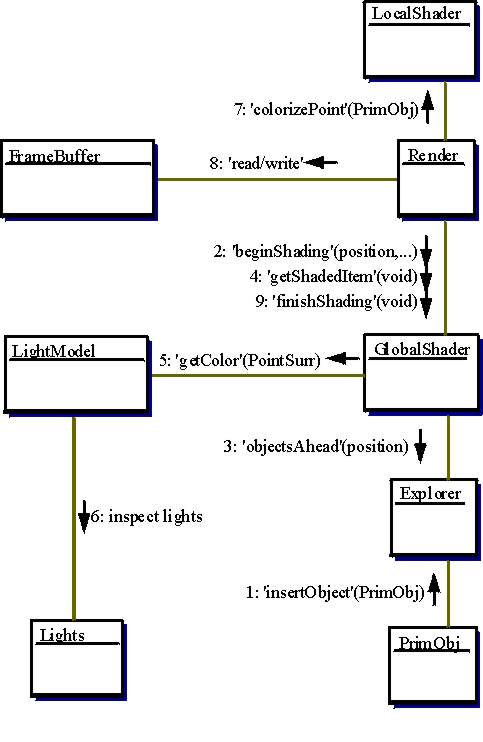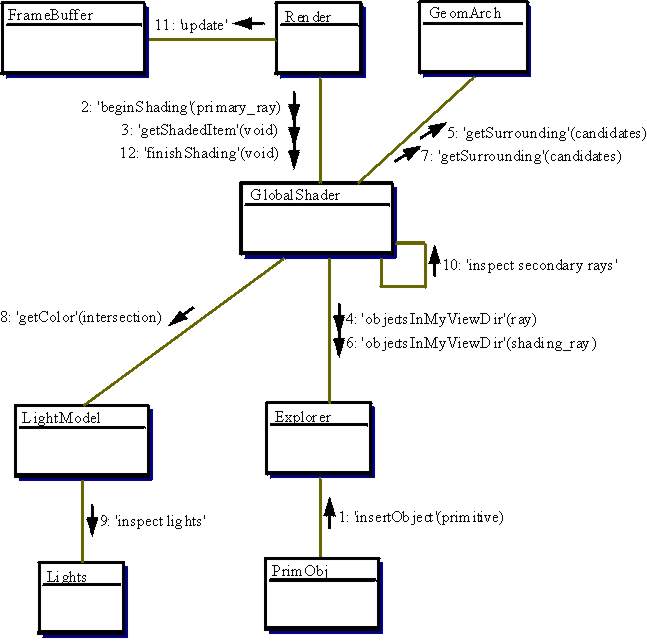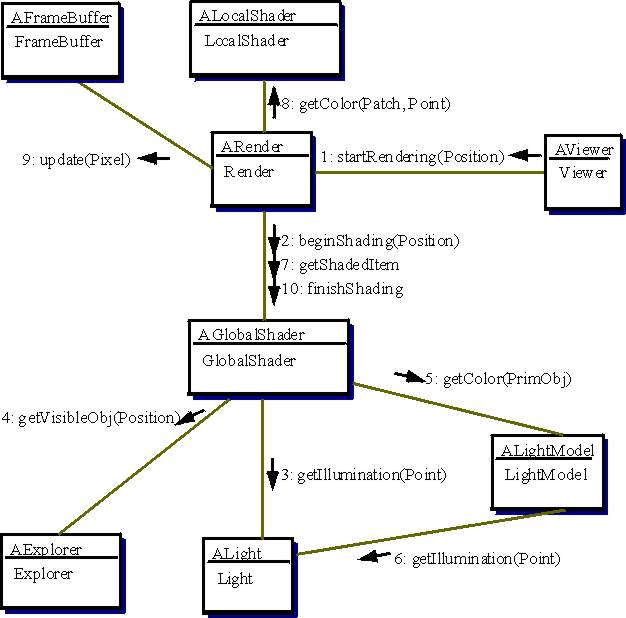
Figure 1: General decomposition - association
Figure 2: General decomposition - collaboration
We use the following classes:
Figure 3: Communication protocol for flat model
At the beginning the object Render sends message
GlobalShader::beginShading()
to initialize rendering process. The method beginShading() has an
argument describing view direction. It is also capable to
discover ordered objects using Explorer.
This is done by method Explorer::objectsAhead().
In the next steps Render sends vantages to GlobalShader.
GlobalShader
inspects lights and returns actual primitive with precomputed informations
for LocalShader such as colors in vertices or just one color per
surface. Render sends the selected primitives to LocalShader.
LocalShader returns colored pixels which are written
by Render to screen.
The collaboration diagram of the rendering process is shown in
Figure 3.
Figure 4: Communication protocol for ray tracer
Render generates primary rays and takes
the resulting colors of pixels from GlobalShader.
Render controls the sampling strategy. It may
cast one ray for each pixel,
or more sapling rays per pixel with subsequent weighted color averaging.
Using camera parameters Render
sets inital ray direction according projection method.
GlobalShader is invoked by beginShading(primary_ray)
message.
From Explorer he takes candidates for
intersection and from object GeomArch
it takes differencial neighborhood for one real intersection.
The next step is the computation of color contribution to ray.
This is done by inspection of lights.
GlobalShader casts the shading rays to light sources and
intersection computation of these rays with objects in scene is done
(via cooperation of Explorer and GeomArch).
When intersection with some object exists and if it is nearer
than light source then the tested surface point is shaded by this object.
In the last step GlobalShader generates reflection and
transparency rays
and calls itself recursively for these secondary rays.
Graphic system implementing simple version of
progressive radiosity can work by the next schedule.
In the begin Render calls method
GlobalShader::beginShading() and it starts rendering process.
GlobalShader gets the position of light sources.
These are used as starting surfaces
for energy distribution. In the next step GlobalShader
takes visible objects from Explorer, computes form factors
and deposits shooted energy to patches.
Patches with deposited energy
are stored locally and they are used in the next iteration step.
Next steps are similar to flat model. Render takes precomputed
primitives by method GlobalShader::getShadedItem(),
these primitives are sent to LocalShader and colored pixels
are drawn to frame-buffer.
Figure 3: Progressive radiosity communication protocol
In the real world we may find the following situation:
The world contains many static objects such as houses or roads.
Adventurer going to some unknown piece of land
starts with the empty map (blank sheet of paper) and he draws the
dicovered objects to map - first with low precision and without details,
later he can add precise measurements and his map is getting more useful.
First this operation takes some time and so he proceeds slowly.
But the next travels through already mapped area should be faster
and more effective.
Our idea is to use the above described situation as paradigm for
the dynamic scene with global rendering.
We have already proposed and implemented
the model in which explorer is looking at map during his travel
in space. It offers many possibilities to experiment with
different space sorting structures, bounding volumes speed-up techniques
etc. The research of these advanced models is the topic our current
and future work.
[1] Chen S.E., Turkowski K., Turner D.:An Object-Oriented Testbed for Global Illumination., In: Laffra et al. (Eds.) Object-Oriented Programming for Graphics. Springer-Verlag, 1995, pp.155-166 [2] Fellner,D.W.:Extensible Image Synthesis., In: Object-Oriented and Mixed Programming Paradigms, Wisskirchen P., (Ed.), Focus on Computer Graphics, Springer, Feb. 1996 [3] Slussalek,P., Seidel,H.P.:Vision - An Architecture for Global Illumination Calculations., In: IEEE Trans. Visualization & Computer Graphics 1(1), 1995
3. Case study I - Flat Model

4. Case study II - Ray Tracing

5. Case study III - Progressive Radiosity

6. Advanced techniques and future work
References